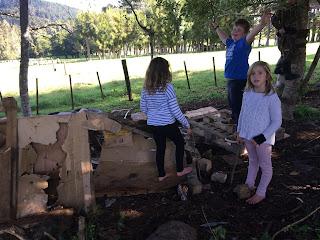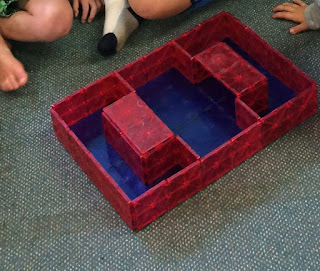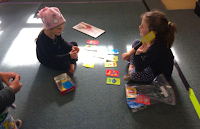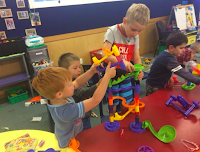I will start with talking about our 'timetable' as that is a question I get often...coming from a traditional class we all seem quite hung up on timetables, but I am very proud to say that this year we have finally discarded this.
We do not have a 'timetable' for ourselves to refer to, but this is our overview for each week. I keep this in my planning scrapbook and write in what we have actually done each day. Basically the overview is just that, an overview, the day may not necessarily go that way, but we have our items that we want to cover in some way each day. I love our morning ritual, and even though rolling play while we are doing the roll does take longer, it feels more gentle in a way. It also gives us time to actually greet children, and for those children that are late, it feels less stressful.
I really like writing in what we have done after the fact, it feels so much more real to me in terms of following the children's interests and urges. While we may discard some facet of what we 'planned' to do on one day, it is likely this will be made up for on another day.
Fitting in the 'required' learning areas is also a question that is often linked to the one about the timetable. It does take a bit of juggling at times, but it is possible, however I think often the 'required' learning areas need to be filtered through a lens of developmentally appropriate practice. If what we are doing is not appropriate for the developmental stages of our children, why are we doing it, who are we doing it for? If the answer is because we have to, and I really don't know (or in some cases management) then perhaps it is time some sit down discussions happened around this topic.
It is entirely possible to cover those things that are necessary and pitch it appropriately for a range of developmental stages. However I have come to really believe that the sweet spot for my munchkins to sit on our mat for any directed learning is about ten minutes...unless we are in Number Agency and then for some reason, perhaps because of the playful nature of agency, would stay in character and in agency for more than an hour if that was what I wanted. Of course it is not and the sweet spot for agency is about 45 minutes excluding getting into and out of agency. I try very hard to keep to these sweet spots and very much use the children as my guide in this.
So what have become the areas where we use teacher direction now?
Reading - specific teaching of reading only happens with those that are developmentally ready and interested and it is done individually throughout the day. If a child is showing developmental readiness according to the checklist we have created (which for us is working really well) but they show no interest at other times of the day in learning to read, we will wait, as nothing is gained by pushing a child that has no interest in what we are trying to teach them. We have discovered decodable books (I have discussed this in another post) and these are transforming the reading process for our children, I LOVE them! After researching the reading brain, I now understand why explicit teaching of letter/sound relationship and all the bits and pieces that go with it is so important. In fact it has really challenged my old thinking about high frequency words and I love being challenged, challenge can have transformative effects on my teaching, and in turn only positive effects on the learning in my classroom. We will have 46 children in our space, with three teachers on most occasions. Only 21 of these children will be reading with us. We only read with them twice a week. A bit more about this here.
In my second book about play, found in my store here, I grappled with my approach to reading and really wanted to embed a more child initiated process. This has really happened quite naturally, we have a gorgeous class library, and those interested children are often found browsing at books and will frequently ask us to read to or with them. The other way I have worked at embedding this sense of agency within children is by having something I call interest reading after shared book, or at another time as our day allows. This involves children self-selecting, browsing and taking a book home to share. We have found children to love this process and they clearly have their favourite books that they love to read over and over again. This is a screenshot of the poster we made to explain this process to parents and outline what we wanted from them. This process usually lasts for just over ten minutes.
Below are pictures of the children engaging with this process and a snap of part of our library. Books are in boxes according to type, making it easy for children to find a box of books that interest them to browse at.
Writing
If you have been following my posts, you will know I use what I call a storytelling approach based largely on using pictures to tell a story, but also with a huge focus on oral language development. This post talks more about this.
Term 2 saw us continue with storytelling and the introduction of Edward the Enchanted Tree. This is a clip of Edward....taken on a phone, so it is not great quality, but you get the idea.
The response to Edward has been incredible, they ask for him every day and don't even notice that as we progress they are actually making up more and more of the story on their own. I have also found, similar to in agency, that they are more inclined to do what Edward tells them to do, so he is able to remind or children that have started writing about those things they are working on.
In terms of how this works in our play-based learning, we have settled on a rhythm of perhaps 10 minutes of 'direction' and then children spend time doing some practicing, this is 5 minutes, or if they want to keep going they do. We all come together as a group, and the gentle nature of just engaging at their own comfort level means there is zero stress.
Maths
Obviously our maths is delivered through Number Agents. The name is misleading as strand is delivered through this as well, usually integrated, because that is how mathematics truly works.
Our first two terms have been amazing, I am really noticing the connection of agents to the world growing stronger and stronger and for some the level of engagement borders on obsession.
Excluding entry and exit from agency or maths time usually takes 40 - 45 minutes. I have now managed to introduce all of the characters, excluding one that is new and will arrive this term...
 |
| Witch is Mine! |
This slightly scary looking puppet will be best friends with the Grouping Goblin and will be used to introduce some understanding of division. In past years I have not explored grouping or division, but the use of dot talks and visual images has really led agents into using grouping as a strategy. I will need to do a new addition to the book to add all of the changes I have made.😜
I have really enjoyed the playful way children have added their own storylines to agency and have enjoyed just going with it. It is important that they are given time to add to the narrative each agency session, it is what they love, to build the imaginary world that they exist in.
I enjoyed our tension filled end to agency over two sessions. I think I will add to this narrative a bit more this term with other lead agents around the country being kidnapped and use being asked to assist.
I know that I have really got the best mixture of play, drama and problem solving when children start asking to go into agency and when I start to see lots of dramatic play going on, this has been the case in term 2, so I am very happy.
Agency generally happens in the session between morning tea and lunch, however this again is flexible. If I have limited time, we just do a problem rather than the rest of the programme.
I do not teach Wednesday or Friday and on those days agents have a strand focus and focus on having agent eyes as their super power. They have a client with a problem, but this is delivered through a message in a bottle. They love it and it works well.
Phonics
I absolutely believe that children need to be exposed to the sounds of language and that a rich oral language approach contributes to this. We love nursery rhymes and will have fun singing the ones we have learned when we have a few minutes in our day. I found a few years ago that learning a range of nursery rhymes off by heart really assisted working memory, so simple, but very effective.
My dilemma over the year has been how a structured phonics session can fit within a play-based class that I have structured around an awareness of developmental stages. I am very aware that some children are not at all ready to be formally engaging with phonics, but I am also very aware that hearing sounds and developing a rich understanding of language is vital. Thinking about this I created this diagram for literacy development and have shaped my 'phonics' sessions around an awareness of the four first stages as outlined below merging with the fifth stage.
Like my writing I wanted this session to be gentle, non-threatening and for children to engage at their level of understanding. We then will directly teach phonics (the last three stages) individually as children have moved onto reading and writing and on a need to know, ready to know basis. We will sit with children individually and talk explicitly about the knowledge they need next.
In our whole group sessions we will spend a maximum of 10 minutes, we base our session around these little guys.
The children love them, and they make the link between the letter and the sound explicit and also demonstrate how they can join together to make words.
We do have a go at writing a letter, or working on pre-writing shapes which we call volcanoes, mountains, valleys, craters, lines from top to bottom and lines from left to right, we also may focus on the shapes below. These pre-writing skills are crucial before children can learn to write actual letters.
We may some time on hand exercises.
I call the session 'phonics' but really it is a mixture of things and closely links in with what we talk about in our writing sessions. We have settled in to having these sessions at the beginning of the day as it feels right. Absolutely no more than ten minutes. Some children will then go away and spend time practicing on their own and this is our opportunity to support them if it seems appropriate to do so.
Growth Mindset - Emotions - Kindness - Play-based reflections
These elements have become really crucial to me, these operate on no designated schedule, however we will find moments to share books with a focus on these areas, songs, and photos taken during play-based time that we can reflect upon through a social-emotional and dispositional lens.
It is most likely that we do these reflection sessions in the in-between areas of our day. Those moments we come together, with a few moments left before we need to move to the next thing.
This series is awesome, the other videos can be accessed through Class Dojo, they are called the Big Ideas series.
There are so many lovely songs on youtube that reinforce a growth mindset.
And some gorgeous ones about kindness
These short elements in our day have become very important. Observing the play and really thinking about what is going on through a lens based on dispositions has allowed me to know what it is we need to reflect on to assist development in this area.
What does the play look like now?
What we decided to do in Term 1 and 2 was take a lot our of our classroom space and just leave items that can be used in a variety of ways. This was the best thing we could do.
The children are in a real rhythm of play now. Before we move off to a play-based session we may reflect on something that we have been focusing on, this may be how to solve problems, a particular part of play we have been impressed with, or maybe a social/emotional focus. Children move off with a clear intention of what they want to do and what we have noticed is that they end up playing with people with the same interest or urge as them, rather than a chosen friendship. This means they play with a range of different children and actually get to make friends with people that have the same interests as them, rather than making friendships of convenience.
Our children spend a lot of time outside and often we can look out the door and see not a soul because they are all in the bush.
We also have a huge construction urge/interest going on at the moment so there is a lot of building, using various materials that are becoming more and more sophisticated.
As an example a group of boys have been obsessed with the magnetic tiles...they initially just seemed to build non-specific towers/buildings etc...but now have started to plan and build specific constructions, here they have made a rugby stadium and a football stadium.
Many of our children have an urge to create, they seek out the paper, scissors, glue, felts and spend time planning and discussing what they want to create, then using these creations in their play. We have had a lot of handbags lately.
Others are really obsessed with our new bike track 'humps' and spend huge amounts of time running up and down. They then discovered the could slide down the sides into the mud and this was so absolutely fun to watch as they tried desperately to stay on their feet while sliding down. Mud is a huge interest, due to the fact that there is a lot of it and we have just gone with it, but encouraged gumboots.
We have a lot of dramatic play, children dressing up and using the puppets pretending to be agents is a common theme. We also have a lot of cowboys that spend time wrangling animals in the bush.
Children do seek out whiteboards and paper to write and make signs, books etc and this often intermingles with other types of play.
Loose parts are popular and children spend a lot of time in imaginative play with these.
Basically play-based time is busy, but very very focused and we have so many opportunities to engage with the play, coach in the play, observe and truly get to know our children.
Another thing that is big at the moment is organising their own games, there is a love of football at the moment and they spend a lot of time organising teams negotiating rules, even subbing on and off fairly. Because the other junior rooms also run play-based time there are often older children in these games too.
Below are a selection of photos that show a range of play that goes on.
The key for us is that play happens most of the day, if children are engrossed in what they are doing we will just let it continue to roll and discard a directed activity, children will engage in a range of activities over the day, with a range of social groupings. It is messy and we do not clean up until the end of the day. Thursday afternoons is junk shed/discovery shed day and they absolutely love it.
Our days are quite fluid and busy, but we love it and are finding that social, emotionally and in terms of dispositions towards learning our children feel leagues ahead of those that used to come from our quite formal/traditional classroom.
Some days it can feel like beautiful chaos, but if you take time to focus in on what is actually happening in the pockets of play inside and outside, the learning that is going on is amazing! We just need a child lens.



Something we want to do this term is to make our spaces feel more homely, this is an idea we picked up when we visited Kamo Primary and saw their gorgeous environments. I can take no credit for the environment that is currently being created below, my wonderful partner in crime has been busy.
Making coverage visual - Finding the Curriculum
Something that I am asked on a frequent basis is how you provide for the curriculum within the play-based environment. I think that it must be hard in a school that requires quite prescribed coverage and feel that this question comes because there is not a shared vision. A shared vision of play would not see a teacher having to prove curriculum coverage because there would be an understanding of the huge amount of learning that comes out of the play and that play is how children learn.
Curriculum is a construct of our education system, it does not exist in the real world...people don't sit there and say we are doing Science now, then move into Social Studies. In my opinion we need to re-shape learning that we give a priority to and how we deliver it.
Ok in saying that I love to capture the learning that comes from the integrated curriculum. We have settled on using seesaw to make the learning visible for the parents and a shared learning story book where we record various parts of our learning that children can reflect back on. It is also like an inquiry record if we are focusing on an interest that has come to the fore. Basically put it is a scrapbook where we paste photos and make notes, it is a document shared as a class and a great reflection of our learning over the year.
The response to seesaw has been awesome and I would really recommend it!
Our sequence of goals, probably best seen as steps into learning is still working really well and it enables me to plot children's progress through these, proving the progress that is happening within a developmentally appropriate context. It also allows me to show where a child has started developmentally and how far they have come. These goals are based on the diagram that I created based on the work of Nathan Wallis. It is simple and user friendly for a play-based class.
I did make a very interesting discovery this term when looking at gross motor skills, specifically related to crossing over, we had a young man that puzzled us, he was really struggling to move through this area and it puzzled us as to why. We watched him during play and then when we asked him to march (which he just couldn't do.) What we realised when we watched him in play was that he had his hands in his pockets all of the time, how could he possible develop these motor skills if his arms were constantly still. This was an easy fix once we noticed it.
That is the true beauty of slowing down isn't it, we get the time to really observe and more importantly to notice.
 I find this vision from Te Whåriki as appropriate for all levels of our schooling system and would love to see it as an umbrella vision.
I find this vision from Te Whåriki as appropriate for all levels of our schooling system and would love to see it as an umbrella vision.
Narratives
Something I wanted to work on this year was creating narratives that captured learning accurately, rather than just commenting on what was going on I wanted to also capture either the dispositions and/or curriculum learning that was going on. This document is the one we have created for our school.
My ability to create narratives is a work in progress, initially we were creating learning stories in google and then sharing on seesaw as a PDF. These were really useful, but not manageable as our numbers rose. Last term we decided to turn this into a paragraph on seesaw. We kept a list of our children and them off each time we had made a deeper comment that informed the parent about an element of learning in a more thoughtful way. I found it was better to make some notes during the day, capture photos and then spend some time after school adding them to seesaw. I see this as the most manageable way of ensuring these take place.
These narratives can also be printed out and glued into their 'learning/assessment journal' which gives a more overall picture of the child, this book captures their progress through our developmental goals.
Invitations and Provocations
Provocations are one of my personal goals this year. What I have found is that this happens best if I am able to observe the play and find the interest or urge, then to think about a provocation that may see children extending on this thinking. If I am in sync enough with the interests and urges going on, the children actually guide the provocations. Earlier last term it was construction, it took very little effort to use pictures and questioning to get them to think more about types of buildings. We ended up with a lovely cardboard castle that they spent a lot of time playing in. Provocations in the way that I have come to use them do not look like they could be in a magazine, they are much more likely to happen within the play and through our reflections. I love using pictures, videos, books and songs to provoke further thought about a topic. I also enjoy watching the learning that unfolds.
Children have expressed interests in camouflage and 'treasures' so I will need to do some thinking about how I can provoke thought around these areas.
We have found that we started to design specific invitations for fine motor skills last term. This was based on a need of a group of children and different invitations were provided each day.
Goals For Term 3
Work further on developing narratives based on dispositions for seesaw.
Create a more homely environment and let children guide this development. Get our pallet house village up and running outside along with our fire pit.
Work further on how to provoke from interests and urges





































































No comments:
Post a Comment